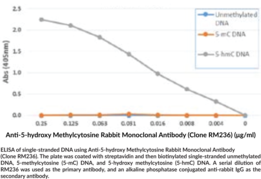Description
5-Hydroxymethylcytosine (5-hmC) is an epigenetic modification formed from the oxidation of 5-methylcytosine by Tet dioxygenases.{17171} 5-hmC is primarily a stable DNA modification, but it can be oxidized by Tet enzymes and its products further modified to generate nonmethylated cytosine, indicating a role as an intermediate in DNA demethylation as well.{49667,29364,49668} It is associated with actively transcribed genes and recognized by a variety of proteins, including proteins involved in DNA repair and DNA metabolic processes.{49667,49668} 5-hmC has been found in all mammalian tissues but levels are higher in the brain relative to other tissues.{49669} The percentage of genomic 5-hmC in mouse cerebellum increases during postnatal development until adulthood, and genes acquiring intragenic 5-hmC are enriched in pathways associated with age-related neurodegenerative disease pathways in adult mice.{20327} In contrast, 5-hmC levels are reduced by up to 8-fold in cancer tissues.{49667,49670} Cayman’s 5-Hydroxymethylcytosine Polyclonal Antibody can be used for dot blot, ELISA, hydroxymethylated DNA immunoprecipitation (hMeDIP), immunocytochemistry (ICC), and immunohistochemistry (IHC) applications.
Synonyms: 5-hmC
Immunogen: BSA-conjugated 5-hydroxy methylcytosine
Formulation: 50 µg of protein A affinity-purified antibody from an animal origin–free culture supernatant from an animal origin–free culture supernatant
Isotype: IgG
Applications: Dot blot, ELISA, hMeDIP, ICC, and IHC
Origin:
Stability: 365 days
Application|ELISA||Application|Immunocytochemistry||Application|Immunohistochemistry||Application|Immunoprecipitation||Product Type|Antibodies|Monoclonal Antibodies||Research Area|Cancer||Research Area|Epigenetics, Transcription, & Translation|Erasers|DNA/RNA Demethylation||Research Area|Neuroscience|Neurodegenerative Disorders



